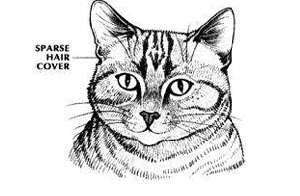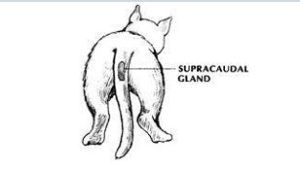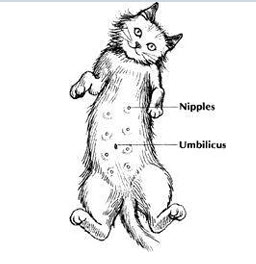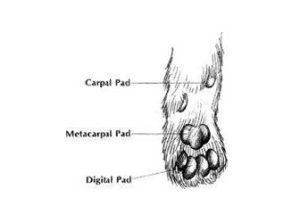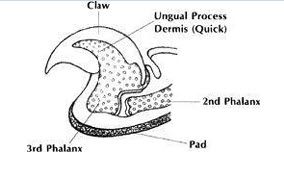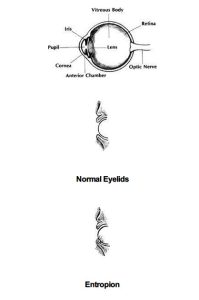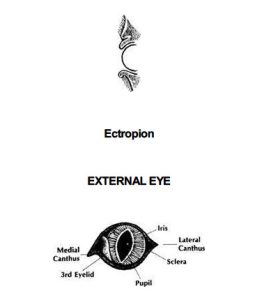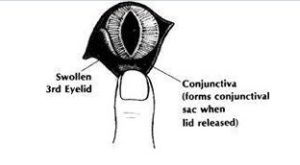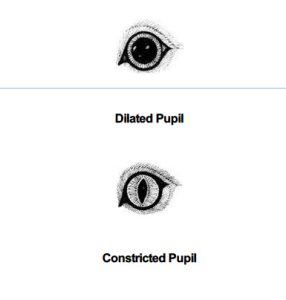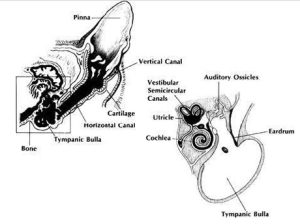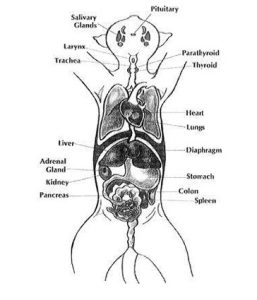The Classic Comprehensive Handbook of Cat Care
SKIN (INTEGUMENTARY SYSTEM)
The integumentary system consists of the skin and its specialized modifications: the hair, the foot pads, the claws, and the anal sacs. Your cat’s skin protects his or her body against environmental changes, trauma, and germs. In the skin vitamin D is synthesized; below the skin (in the subcutaneous tissues) fat is stored. Skin is both an organ of sensation and an organ (via certain skin glands) for waste excretion. Unlike humans’ skin, however, the cat’s body skin plays only a minor role in heat regulation.
Skin disease does occur in cats, and the condition of your cat’s skin and hair can sometimes tell you a great deal about his or her general state of health. If your cat is healthy, the skin should be smooth, pliable, and free of large amounts of scales (dandruff), scabs, odorous secretions, and parasites.
Normal skin coloration ranges from pale pink through shades of brown to black. Spotted skin is completely normal and may be seen in cats without spotted coats. The skin (and hair) color comes from a dark-colored pigment called melanin, which is produced and stored in special cells in the bottom layer of the epidermis (outer skin layer).
Examine your cat’s skin carefully. To do this, part the fur of longhaired cats in several places and look carefully at the skin itself. In short-haired cats run the thumb of one hand against the grain of the hair to expose the skin. Be sure to examine the skin in several places over the body, on the legs, under the neck, and on the head. When you are examining the head, note how there is a distinct thinning of hair in front of the ears. This is called preauricular alopecia; although the degree varies between cats, its presence is normal. It marks the site of the temporal glands, microscopic skin glands thought to be important in scent marking. Similar glands are present in the skin at the corners of the mouth, on the chin, and on the tail.
REAURICULAR ALOPECIA
Any buglike creatures you see attached to your cat’s skin or hair or that quickly move away as you part the hair are external parasites and should not be there. They are likely to be fleas, but may be lice, mites, or ticks. Small salt- and pepperlike, white and black granules may be flea eggs and flea feces. A specialized area of skin of particular interest to owners of mature tomcats is the supracaudal organ (tail gland). This is an area of numerous and large oil-producing glands located on the upper surface of the tail.
Although it is present in all cats, it is not particularly evident unless there is excessive accumulation of the gland’s oily secretion. If this has occurred in your cat, you will find an area of greasy, brownish secretion as you part the hair on the top of the tail. This may be accompanied by stringy, oily hairs. This unsightly condition is commonly referred to as stud tail (feline tail gland hyperplasia) and is sometimes relieved by castration and fastidious grooming.
Roll your cat on his or her side or back to see where the skin forms the nipples of the mammary glands (breasts). The mammary glands themselves are skin glands that have become modified for the production of milk. Male as well as female cats normally have four nipples on each side, although some cats have as many as five pairs. The prominence of the nipples and mammary glands in the queen (female cat) varies with age and stage of the estrous cycle. Examine your cat’s mammary glands by feeling the areas between the nipples and a wide area around them. In a normal male or anestrous female you should not be able to feel any lumps or bumps. If you find any, discuss their importance with your veterinarian.
VENTRAL ABDOMEN
If you have a young cat with short abdominal hair, you may notice a faint scarlike area on the skin at the midline near the area where the chest meets the abdomen (belly) while you are examining the breasts. This is your cat’s umbilicus (belly button). If you see a lump in this area, it may be a n umbilical hernia. (See and decide whether or not you need a veterinarian’s help.) Now return to the head to examine your cat’s nose. The skin is modified over the nose so that its superficial layers are thick and tough. This skin has no glands, but is usually moist from nasal secretions and feels cool as a result of evaporation. A cool, moist nose or a warm, dry one, however, is not an accurate gauge of your cat’s body temperature; use a thermometer.
Cats’ noses vary widely in coloration. Colors anywhere from salmon or pale pink through brown to black are normal, as are spotted noses. A brightly colored nose that becomes pale or white can be a sign of illness, so be sure to become familiar with the normal appearance of your cat’s nose.
The skin is also modified to be thick and tough over the foot pads. The deepest layer of the foot pads is very fatty and acts as a cushion to absorb shock. The middle layer (dermis) contains eccrine glands, the only skin glands in the cat equivalent to humans’ heat-regulating sweat glands. If you feel your cat’s foot pads when he or she becomes excited (e.g., on a trip to the veterinarian’s office) you will find that the pads become damp with eccrine gland secretion. These glands are also responsible for the steamy footprints you may see when your cat crosses the sidewalk on a warm day
FOREPAW
The foot pads are named according to which bones they overlie —digital, metacarpal (metatarsal in the rear feet), and carpal (none in the rear). Examine your cat’s foot pads and learn their names. Knowing the names may help you describe the location of a problem to your veterinarian.
Two unusual modifications of the skin are the anal sacs. They are located internally under the external sphincter muscles of the anus at about the four o’clock and eight o’clock positions. If you lift your cat’s tail directly upward you can see the small opening where each duct empties on each side near the opening of the anus. If the glands are full, a drop or two of brownish fluid will often drip from the openings as you lift the tail. This odorous anal sac secretion may serve to mark your cat’s stool with his or her particular identification tag. They are also often emptied explosively in stressful situations. You may be able to feel the full anal sacs by placing your thumb externally on one side of the anus and your index finger on the other side, then gently moving your fingers up and down. Full glands feel like firm, dried pea-sized objects beneath the skin. Occasionally a cat’s anal sacs don’t empty properly on their own; then you or your veterinarian must empty them.
ANAL SACS
Claws (toenails) are specialized in cats for digging, traction, hunting, and protection. To examine your cat’s claws, extend them as explained. The outer layer of the claw is horny and may be pigmented or unpigmented.
The inner layer is the dermis (quick), which is highly vascular (contains many blood vessels) and is continuous with the connective tissue covering the third phalanx. Even in a dark-nailed cat you can usually see the dermis as a pink area inside the claw when it is held in front of a light. Cats normally keep their claws sharp by constant conditioning by which the old, dulled, and worn outer layers of the claws are pulled off. This normal scratching behavior sometimes becomes undesirable in cats confined indoors. Providing a cat with his or her own scratching post or nail trimming or declawing are ways to help solve the problem.
CROSS SECTION OF CLAW
Cats have three basic types of hair: guard hair, fine hair, and tactile hair. Tactile hairs (whiskers) grow out of very large sensory hair follicles on the muzzle and chin, at the sides of the face, over the eyes, and from large hair follicles located on the back of the foreleg just above the carpal pad. Their sensory function is a significant aid to your cat’s vision and hearing and is thought to be of particular importance in helping cats orient themselves in poor light. Guard hairs are the longer, coarser hairs that comprise the immediately visible outer part of your cat’s coat. Fine hairs are the soft hairs that make up the undercoat present beneath and between the guard hairs. Fine hairs consist of two types of soft hairs, awn and down or wool.
Unless your cat is Cornish Rex, a special breed with a coat composed only of fine, curly hairs, whether the coat is long or short there are both guard hairs and fine hairs present. Try to distinguish between them in your cat’s coat.
Although you may notice a particular increase in the numbers of hairs your cat sheds in the spring, all cats’ coats are replacing themselves continuously. At any one time some hairs are falling out, some are in a resting phase, and others are growing in. Don’t consider shedding excessive unless you begin to see bare skin areas developing in normally haired sites. A healthy cat’s coat is neatly groomed and clean (although tomcats often look very dirty and unkempt when healthy). The coat should appear glossy and unbroken. Dark-colored coats usually seem to have more natural sheen, so take this into consideration before judging your cat’s coat. After clipping or shaving, the average cat’s coat takes three to four months to grow back fully, but it can take much longer, especially in long-haired cats.
EYES
Your cat’s eyes are similar in structure and function to your own. Light entering the eye passes through the cornea, anterior chamber, pupil, lens, and vitreous body before striking the retina. Specialized cells in the retina (the rods and cones) convert light striking them into nerve signals that pass to the brain via the optic nerve. In cats these impulses result in an image thought to be perceived in various shades of gray and perhaps some blue, green, and red, and various degrees of brightness. Although color-vision is present to some degree, it is so limited as to be insignificant in the daily life of the cat. Located behind the retina is an area of tissue called the tapetum lucidum. Its function is to reflect light that has already passed through the rods and cones back to them (increasing visual acuity in dim light). It is the structure that is responsible for the appearance of cats’ eyes “glowing in the dark.” As you examine your cat’s eyes you will see that each is surrounded by two modified skin folds, the eyelids.
The edges of the lids should be smooth, even, and not rolled in (entropion) or out (ectropion). Cats do not normally have eyelashes. Look for lashes on your cat’s eyelids and if any are present, be sure that they do not turn in abnormally to rub against the eye. Between the eyelids at the medial canthus (corner of the eye near the nose) you can see the third eyelid (nictitating membrane). It may be pale pink or partially pigmented. Its normal position over the eye varies from cat to cat and has some relationship to the presence of disease. Roll back the upper or lower eyelid by placing your thumb near its edge and gently pulling upward or downward. This allows you to view the inner lining of the lids, a pale pink mucuous membrane called the conjunctiva.
EYEBALL
EXAMINING THE EYE
The visible part of the eyeball consists of the cornea, bulbar conjunctiva, anterior chamber, iris, and pupil. The bulbar conjunctiva is a continuation of the lining of the eyelids that covers the surface of the eyeball except for the area of the cornea. If it contains pigment the area may look spotted or dark. In unpigmented areas the bulbar conjunctiva is transparent, allowing the eye’s white fibrous coat (sclera) and the fine blood vessels that traverse it to be seen through it. The cornea should be completely transparent. Through it you see the anterior chamber, iris, and pupil. The color of the iris varies widely among cats. Greens and yellows predominate, but many other iris colors are possible, among them orange, blue, and lavender. Sometimes cats have a different iris color for each eye.
White cats with this condition (“odd eyes”) or with two blue irises are often deaf or hearing impaired (Waardenburg syndrome). The iris controls the size and shape of the pupil. Along with the eyelids, the pupil controls the amount of light allowed to enter the eye. Pupils should constrict simultaneously in bright light and dilate in dim light. When only one eye is exposed to light or darkness, the pupil of the remaining eye should constrict or dilate when the exposed one does. If your cat’s eyes are normal when you test their response to light you will find that the pupils are round when dilated, slitlike (vertically) when constricted.
EARS
The external part of the ear, which you can see when casually looking at your cat, is called the pinna. The pinna receives air vibrations and transmits them via the ear canal to the eardrum. The outside of the pinna is covered with haired skin like that covering the rest of your cat’s body. The inside is also partially haired, although the hair there is more sparse than that on the outside. Any visible unpigmented skin lining the inside of the pinna and ear canal should be pale pink in color. Bright pink or red is abnormal. All visible parts of the ear should be fairly clean. Normal accumulations consist of very small amounts of clear to slightly yellowish brown waxy material. Large amounts of this material, black waxy material, or sticky foul-smelling secretions are abnormal. If your cat’s ears look normal to you, or your veterinarian tells you that your cat’s ears are normal, smell them. This odor is the smell of a healthy ear. Deviations from this smell may indicate ear trouble even if you can’t see any external indication of it.
Notice on the drawing that the ear canal is vertical for a distance, then becomes horizontal before it reaches the eardrum. This makes it impossible for you or your veterinarian to see very deeply into the ear canal without a special instrument called an otoscope. An advantage of this type of ear canal structure is that it allows you to clean quite deeply into the ear canal without fear of damaging the eardrum as long as you clean vertically.
ANATOMY OF THE EAR
The structure and function of your cat’s middle and inner ear are very similar to your own. Vibrations reaching the eardrum are transmitted through the middle ear by small bones, the auditory ossicles, to the vestibular window. From the vestibular window the vibrations enter the inner ear where the cochlea converts these mechanical stimuli to nerve impulses that travel to the brain via the auditory nerve. In addition to the cochlea, the semicircular canals and utricle occupy the inner ear. These organs are important in maintaining the cat’s sense of balance.
Hearing is present in cats when the ear canal opens at twelve to fourteen days. In general cats can distinguish among sounds better than either people or dogs. They can also hear higher pitched sounds (up to 65 kHz) than humans, whose hearing range extends to about 23 kHz.
